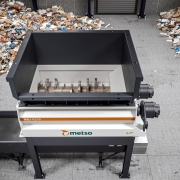Cameroon: More Waste Creates More Recycling
The Republic of Cameroon faces the same challenges like many other developing countries. Waste management and recycling are not at the forefront of the Central African country, but they are becoming increasingly important.
Economic growth as well as changing consumption and production patterns have resulted in rapid increasements in generation and use of plastics in the Republic of Cameroon. According to scientists and the media, the annual consumption of plastic materials has increased tremendously, although exact figures are not available. The same applies to the plastic waste generation in the country.
In Douala, with more than three million inhabitants the largest city of the country and its economic capital, plastic consumption has expanded much more than in other Cameroonian regions in consequence of rapid urbanization and economic development. “Due to the increase in generation, waste plastics are becoming a major stream in solid waste,” Maria Atongajua from the International Institute of Tropical Agriculture, Cameroon, stated 2016 in an abstract in the context of the International Conference & Expo on Green Energy, Recycling & Environmental Microbiology in Atlanta (USA). “After food waste and paper waste, plastic waste is the third major constituent at municipal and industrial waste in Cameroon. Even the rural communities in Cameroon with low economic growth have started producing more plastic waste due to increased use of plastic packaging, plastic shopping bags, PET bottles and other goods/appliances using plastic as the major component.” Owing to lack of integrated solid waste management most of the plastic waste is neither collected properly nor disposed of in an appropriate manner to avoid its negative impacts on the environment and public health, she gave account. The plastic waste would be often the most visible component in waste dumps and open landfills in Cameroon. In her opinion, recycling can provide an opportunity to generate energy and resources.
According to a research article on “Municipal solid waste generation, composition and management in the Douala municipality” by Innocent Ndoh Mbue, Bitondo D (both from the University of Douala) and Balgah Roland Azibo (University of Bamenda), the amount of plastic waste disposed of was estimated at 441,817 tons in 2013, which would represent 15.4 percent of Douala’s waste stream.
Plastic recycling
With regard to plastic recycling, there are some private initiatives in the Republic of Cameroon. One example is “Coeur d’Afrique”, the association of retired Cameroonian professional footballer Roger Milla. As reported by the publication “Business in Cameroon”, it intends to open this year in Douala another recycled plastic waste-based pavement production plant. The first plant was established in Yaoundé, the country’s capital. It employed at the time 20 people permanently (and contributed to the creation of more than 300 indirect jobs in waste collection chain). The processed plastic waste was used to produce ecologic pavements.
Another example is Namé Recycling, a Belgian-Cameroonian company, which started up a PET plastic recycling operation based in Limbé, in the South West of Cameroon. In June 2017, “Business in Cameroon” gave account, that the company extended its services to the city of Yaoundé, where plastic and packaging waste, generated by households and companies, is to be collected – and recycled into reusable products.
Nearly one year later, in April 2018, it has been released that Namé Recycling will recycle all the plastic waste, which the brewing company Société anonyme des brasseries du Cameroun (SABC) produces in the country. SABC also informed that this year its objective is to recycle 30 million plastic bottles (three times the volume recycled in 2017). “The second phase is about domestic wastes. Objective: recover 80 percent of the bottles produced”, the group was cited.
E-waste
According to a study from the University of Maroua, published in 2014, the awareness of e-waste in the country is low despite increasing dependence on modern technologies that generate e-waste. The author, Cornelius Tsamo, conducted a survey of 33 EEE (electrical or electronic equipment) repair workshops and the responsible bodies regarding waste management in the town of Maroua, located in the Far North Region of Cameroon.
The analysis revealed that 1,628 different e-waste items were found with an average flux rate of one to four items per week. Only six percent of items brought to the workshops could be repaired. More than 90 percent of the equipment would enter the e-waste stream, he stated. “The majority of the waste is stored in the workshops, and parts recycled when necessary. 87.9 percent of those manipulating these e-waste items do so without any protection, as 12 percent of them are aware of the toxicity of these wastes. The local councils have no e-waste management plan as no legislation exists to that effect. There is complete lack of awareness on this type of waste to the public as well as the main actors that should be responsible for their management stemming from poor policy and regulatory systems,” Cornelius Tsamo wrote in 2014.
In this field, the situation changes too. MTN Cameroon – part of the MTN Group (Mobile Télécommunications Network) – and Sweden-based technology and services provider Ericsson have been working together in 2017 under the Product Take Back program (E-waste take back) to minimize the potential environmental impact associated with the disposal of decommissioned electrical equipment. It has been reported in December 2017 that Ericsson has gathered 53 tons of waste in Cameroon and sent this amount to its recycling partner in South Africa.
The E-waste initiative was introduced to MTN Cameroon as part of Ericsson’s modernization project with MTN. The project involved expanding both the core and RAN (Radio Access Network) for MTN Cameroon. On the radio side, it included 3G (a third-generation [3G] wireless standard) expansion on 80 sites and LTE (Long Term Evolution, a mobile communications standard) expansion on 52 sites.
Throughout the program, four 40-foot containers have been loaded with equipment at MTN Cameroon’s warehouse facilities in Yaoundé and then transported by sea to the Ericsson-approved recycling partner in Durban, South Africa. There, the equipment was sorted and dismantled for the final recycling step. According to Ericsson Cameroon, the recycling rate is 98 percent of all materials.
Cameroon’s waste management
The global initiative for sustainable development marked by the Rio Summit in 1992 and the aims of Agenda 21 led to a regulatory framework of waste management in the Republic of Cameroon, Veronica Ebot Manga (University of Buea), Osric Tening Forton (African Development Bank) and Adam D. Read (University of Northampton) stated in an article, published in 2008. As reported, a Ministry of Environment and Forestry (today: Ministry of Environment, Nature Protection and Sustainable Development Ü www.minep.gov.cm, responsible for guidance on waste legislation) was established and a National Environmental Management Plan developed in 1992. But over time the relevant ministerial departments have been transformed (separated or merged) into different ministries “which have devolved powers related to waste management”.
However, this is not the only reason, why much of the country’s municipal solid waste management practices have remained unaffected. Waste management is still regarded as an activity which is centered upon collect and dump somewhere else, the authors described the situation. “This reality is in stark contrast with current legislation and regulations that are framed within the formal policy goal of environmental sustainability.”
While the policy framework would set out strategies to protect environmental resources and promote materials conservation through safe disposal and materials recovery respectively, “poor waste collection and indiscriminate as well as improper disposal dominate local Municipal Council practices,” the authors found. “Failures in the implementation of adequate policies at the local level have been attributed to factors such as lack of funding, low staffing levels, political interference, implementation of inappropriate technologies and relative cost.” One reason was the number of actors. According to the information, several ministerial departments have mandates to implement solid waste management regulations; the highest body responsible for municipal solid waste management is the Inter-Ministerial Commission for Municipal Waste Management in Cameroon. This range of responsible bodies would lead to inefficiencies, as “the current regulatory system relies on a top-down approach to decision making wherein the ministerial departments are able to exercise control over local councils which have limited autonomy. This results in decisions that reflect political inclinations rather than scientific reality.”
The amount of domestic waste, generated by about 23.5 million Cameroonians (estimation in 2016), can only be estimated: Experts speak of 5.5 million tons a year – or 16,000 tons a day (five to eight percent of this quantity is assumed to be plastic waste). The country’s major waste management contractor is the Cameroon Hygiene and Sanitation Company (Hysacam). The private firm was founded in 1969, is based in Douala and Yaoundé and handled in 2017 waste management services in 17 cities throughout the country for 15 million Cameroonians; Hysacam collected over 1.5 million tons of waste a year or 4,000 tons a day. According to the information supplied, the company operates right across the waste management chain, from collection to processing, employs 4,000 people and has a fleet of several hundred trucks.
Actions to protect the environment
At the Paris Climate Change Summit in 2015, Cameroon’s President Paul Biya reaffirmed the country’s engagement to reduce greenhouse emissions by 32 percent by 2035. In August this year the online publication “Cameroon Report” informed, that the Ministry of Environment, Nature Protection and Sustainable Development sanctions some 395 companies for violating environmental laws. The list includes companies illegally importing hazardous waste into the country as well as businesses using and distributing non-biodegradable plastics, to name but a few categories.
With regard to plastics, the “government has embarked on several sensitization campaigns to protect the environment, especially from dangers caused by the use and disposal of plastic waste which constitutes ten percent of the six million tons of plastic waste disposed of nationwide every year,” the “Cameroon Report” wrote. “During the commemoration of this year’s edition of the World Environment Day, the Minister of Environment, Nature Protection and Sustainable Development, Hele Pierre reiterated government’s resolve to end the use of non-biodegradable plastics. He also said people circulating and encouraging the use of such plastics will be hunted down, noting that inspections are being carried out while customs officers are also preventing the importation of such plastics.”
Business opportunities
According to the forecast of the International Monetary Fund (IMF), Cameroon’s Gross Domestic Product (GDP) should grow 4.0 percent in 2018. This was confirmed by an assessment from the global credit insurer Coface (Compagnie Française d‘Assurance pour le Commerce Extérieur) the “African Business Magazine” reported in April this year and stated that the company was “counting on infrastructure, energy and the food business to stimulate Cameroon’s growth in 2018”.
Furthermore, there is a program for economic emergence by 2035. The Presidency of the Republic of Cameroon informs on its website that the President of the Republic, Paul Biya, has transformed the country into a work site for economic emergencies. In the face of the challenges, all Cameroonians are invited to develop Cameroon. “Economic Emergence also requires opening up to partners and foreign investors willing to support our development,” the information said.
In this regard, major structuring projects being executed throughout the country would be “key levers”. One major sector is the agricultural and environmental pole; its aims include environmental protection and ecosystems preservation.
www.prc.cm
www.prc.cm/en/invest-in-cameroon
_______________________
Tenders Cameroon
www.tendersinfo.com/global-cameroon-tenders.php
www.globaltenders.com/tenders-cameroon.php
www.dgmarket.com/tenders/
_______________________
Photo: ink drop / fotolia.com, (Oct. 15, 2018)








